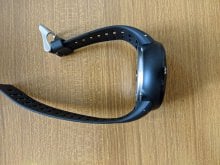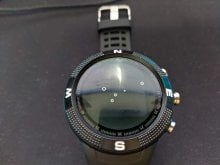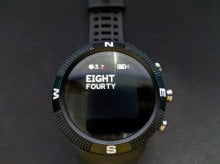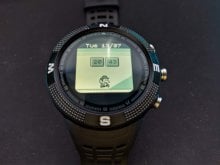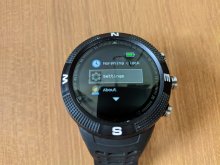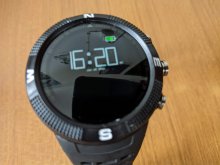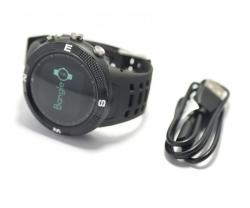 Bangle.js (Hardware)
Bangle.js (Hardware)
Official GBAtemp Review
Product Information:
- Official Store: https://shop.espruino.com/banglejs
As far as smartwatches go, the Pebble is a personal favorite. It was the first smartwatch I owned and got many things right. It surely wasn’t as powerful as current Wear OS smartwatches or full Android watches but it was affordable, had strong community support and could easily be used for up to a week on a single charge. Since Pebble’s acquisition by Fitbit, we haven’t seen a true successor; at least, I haven’t used one with similar performance. The newly-released Watchy came close but it felt more like a dev kit than a fully polished product.
On the other hand, the Bangle.js, an open, hackable smartwatch which was crowdfunded on Kickstarter in 2019, feels more like the Pebble than the Watchy itself. Don’t be put off by its mouthful nomenclature (pronounced “Bangle Dot J S”) as it’s worth taking a closer look at.
At the time of writing, Bangle.js costs £70 on the official store and comes with the following items:
- 1x Bangle.js smartwatch
- 1x Charging cable
- 1x Instruction card
- 2x Stickers
Details about the hardware and software specs can be found below:
Hardware
- IP68 Waterproof: up to 10m underwater
- Nordic 64MHz nRF52832 ARM Cortex-M4 processor with Bluetooth LE
- 64kB RAM 512kB on-chip flash, 4MB external flash
- 1.3 inch 240x240 16 bit LCD display with 2 zone touch
- GPS/Glonass receiver (UBlox)
- Heart rate monitor
- 3 Axis Accelerometer (with Pedometer)
- 3 Axis Magnetometer
- Vibration motor
- 350mAh battery, 1 week standby time
- 5 x 5 x 1.7 cm case, plastic with stainless steel ring
- Can be disassembled with just 4 screws
Software
- Easy to code and debug wirelessly using JavaScript or our graphical editor (based on Blockly)
- Pre-programmed with the Espruino Open Source JavaScript interpreter
- Vast majority of JavaScript ES5 features and many ES6 features including: Regular Expressions, Promises, Arrow Functions, Template Literals
- 40kB RAM for program memory/variables
- Bluetooth 4.2 Advertising, Central and Peripheral mode support with built-in Nordic UART service
- Graphics library with Vector fonts, bimap rotate & scale
- Tensorflow Lite for Microcontrollers AI
- Wear-levelled flash filesystem
- Heatshrink compression
- Upload functions written in C or ARM Assembler
- Built-in wireless debugging
- VT100 Terminal support on LCD
- Program with Web-based Web Bluetooth IDE or Node.js-based command line tools
From those specs, you can see that the Bangle.js isn’t as powerful as a Wear OS watch or the Apple Watch. Espruino, the company behind the smartwatch, mentions as much in the store page, so you should keep that in mind before deciding to purchase it. Rather, it is meant for those who wish to be able to tinker more with their smartwatch given that this is an open and hackable smartwatch.
However, even as a third-party smartwatch, Bangle.js is rather well-built. The matte finish of the body and the stainless steel ring even gives it a premium feel. With its rounded form factor and the cardinal points on the bezel, Bangle.js has a fairly casual look that nevertheless enables it to fit in practically any outfit.
The included silicon straps are comfortable to wear, although if I tighten them slightly too much, the metallic buckle will leave an imprint upon removal. The straps are also removable/replaceable by pushing the pins out but it’s not an easy process as with those spring-loaded straps which I wish were included in the Bangle.js. Moreover, these straps aren’t standard ones, so you’ll have to purchase extra/replacement ones from the Espruino store. As a watch that aims to be “entirely open”, standard straps would have been much more welcome.
Where Bangle.js’ open and hackable aspect is more prominent is with the software. As its name implies, Bangle.js is JavaScript-based and Espruino says that the open software was “designed to be trivial to write your own apps for”. This can very well be the case but without community creations, that wouldn’t mean much.
Luckily, Bangle.js has a very active community that has created over 230 apps for the smartwatch that are available on Bangle.js’ free and open app store. Among these are some games like Asteroids, Snake and Tetris, numerous watch faces, widgets, fitness trackers and navigation tools. You can freely load them on the watch by accessing the app store from a browser and pairing your watch via Bluetooth. I was surprised to find my two must-haves for any smartwatches on the Bangle.js’ app store: a smart sleep alarm and the ‘Sliding Clock’ watch face from Pebble. Of course, these were the first apps (along with some games) that I loaded on my Bangle.js after receiving it.
But bear in mind the limited memory when loading apps as this can cause some crashes/malfunctioning. I came across this issue recently after updating the firmware and got a low memory warning. I couldn’t even access the watch’s menu and got a mini-headache trying to figure out how to fix it. Thankfully, I managed to get the watch to work properly again after trying some suggestions from issues other users had and posted on Espruino’s forum. The latter is quite lively and active, with even Gordon Williams, Bangle.js’ creator, regularly helping out users.
There’s also a resourceful documentation about the smartwatch that can help with troubleshooting and other tutorials. With these, you will find that the Bangle.js is more than a regular smartwatch as you can even use it with IoT projects if you so wish.
But you don’t have to worry about those if you just want a smartwatch as this device works well as one. To pair it to your phone, you will need to install Gadgetbridge (from F-Droid) on your phone and download the Gadgetbridge widget/app onto the watch from the app store. Once paired, you will see notifications from your phone mirrored to the watch. It’s rather basic but helps to give you an idea about incoming notifications from your wrist without having to reach out to your phone. Other apps can also let you control your phone’s music from the watch or get weather reports via Gadgetbridge. I found it to be fun to just try apps from the app store and discovered some interesting ones like a breathing relaxation app and one that loads a map of where you are on the watch with OpenStreetMap.
Of course, you will also find fitness apps like those that can track cycling, runs or your heart rate. However, your options are rather limited as these are single apps and specific apps for other types of workout like weight lifting or HIIT aren’t available. You also won’t find an all-in-one fitness tracker where you can select a workout and have the device track metrics like heart rate, steps taken and calorie burn. Maybe in the future someone might create such an app or other apps for specific workouts for the Bangle.js but as a fitness tracker, this smartwatch isn’t the best one out there.
This is an aspect of the smartwatch that you will have to come to terms with. While it has a growing library of apps, it might not have what you are looking for or what you have been used to with other smartwatches. If you keep your expectations in check, you will still find apps that help you make the most of Bangle.js.
But what you can expect out of it is Pebble-like battery life. Even if the device’s 350mAh battery might not sound like much, it isn’t really power-hungry. In fact, you can easily forget to charge it and still use it as it has a stand-by time of around 1 week. Battery life will, of course, depend on individual usage but I can easily get a couple of days of use by alternating between pairing with my phone, some light gaming on the watch and leaving it on stand-by.
While in use, you might notice that the watch’s and its apps’ interface aren’t as pretty as a Wear OS watch but it packs its own DIY-y charm. Navigating on the Bangle.js is done mostly with the 3 hardware keys, with long-pressing the third button will get you back to the clock. The LCD display has a two zone touch and some apps make use of it but you’ll mostly use the physical buttons, even with games. However, I found the edges of those buttons to be rather sharp and would have been better if they were smoother.
What also adds to the DIY charm is the charging dock. While it is sold separately for £12, Espruino provided one for the purpose of this review. It’s made of laser-cut wooden pieces that you can assemble yourself. The process is a bit fiddly and the individual pieces are rather thin and can get damaged if you aren’t careful. The dock will also isolate the charging cable so it won’t be easily removable for packing or bringing with you on the go. But this DIY aspect does fit with the smartwatch’s overall appeal. This part accessory is also open-source as you can download the files for it and make your own.
You might have also noticed that while the Bangle.js packs a traditional round form factor, the display is actually a square one. Even when in use, you will see a square screen with empty spaces around the rounded edge. At a glance, you might not notice it, especially when the display’s background is black, but upon closer look (or a colored background) it’s quite noticeable. This is rather misleading and, even if I prefer rounded screens, I wouldn’t mind a squared one with less bezel/unused space around.
Using the Bangle.js is fluid and the device is responsive. However, using it requires going through some hoops, like you need a separate app to update the firmware (nRF Toolbox) and another app to mirror your phone’s notifications (Gadgetbridge). But really, it’s part of the charm and endows the device with a somewhat rebellious aura. The UI and UX aren’t as high-end as an Apple Watch or a Wear OS watch but if you don’t mind having all of their bells and whistles, the Bangle.js will prove to be quite fun to use and play around with to customize it in your own way.
Even if Espruino says that this smartwatch doesn’t aim to compete with the Apple Watch and the likes, it can actually be considered as an alternative to what Big Tech wants to feed us with while collecting our data; in fact, we need such third-parties on the market. As Espruino’s first smartwatch, Bangle.js gets many things right and promises a brighter future for subsequent models. It’s surely a niche but if you’re in that niche (or have been looking for a newly-released Pebble replacement), you will find lots to like in Bangle.js.
Verdict
- Open and hackable smartwatch
- Affordable
- Battery life
- Strong community support
- Build quality
- Non-standard straps
- Relies on several apps to pair with phone and updating firmware
- Square screen on a rounded form factor is a bit misleading
- Sharp edges of physical buttons

